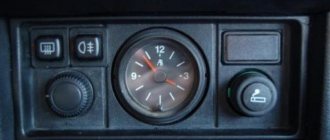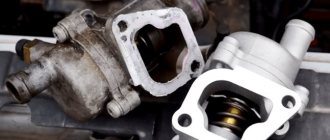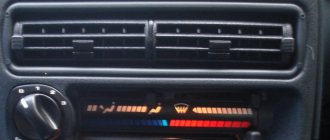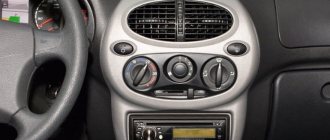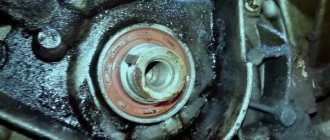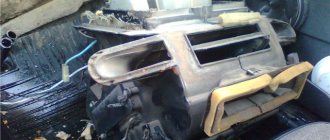During the operation of a car, problems often arise related to the efficiency of heating the interior. Such stove breakdowns can be detected both after the summer period (the stove has not been used for a long time) and when the heater is turned on again in the winter (the stove suddenly stopped working).
The following signs indicate a malfunction of the stove:
- after the engine warms up, completely cold air comes from the stove;
- instead of hot air, warm air from the stove enters the cabin;
- at high speeds the stove heats up, but in idle mode it blows cold or slightly warm air, etc.
It is important to understand why the stove blows cold air, as well as how to fix this problem. Read more in our article.
Low coolant level or air lock
avto-cool.com
Due to a leak at the connection points of the pipes or on the radiator, the coolant level in the system may decrease. This will worsen its circulation inside the heater radiator and affect its heating. Air pockets that form when replacing or adding antifreeze have the same effect.
What to do
Check the coolant level and add if necessary. If there are leaks, fix them.
To get rid of the plug, open the cap of the expansion tank and radiator (if equipped), and then squeeze several times with your hand all the thick hoses that you can reach.
Start the engine, turn the heater to maximum and let the car idle until it warms up completely. To be sure, it would be good to drive onto an overpass or some kind of hill to lift the front of the car and help the air escape. This may cause a small amount of antifreeze to splash out - be careful.
The stove does not heat after replacing the heating radiator on Kalina
Often, car owners think about the serviceability of the stove only at the beginning of winter. But sometimes it can fail. Kalina is no exception. On it, like on many other Volga-made cars, the stove breaks down. For what reasons does this happen, and how to fix this problem? All this will be discussed further in our article.
As you know, the cabin heater has its own radiator. It is filled with coolant. This design is part of the main cooling system. If the stove on the Lada Kalina does not heat well, the reasons may lie in the low level of antifreeze. Open the hood and check the level in the expansion tank. It should be between the minimum and maximum marks.
This is another reason why the stove on Kalina does not heat well. The problem is that the flow of antifreeze is directed to the cabin heater only after the coolant has warmed up in a small circle. A thermostat is a kind of valve that controls the flow of fluid in the system. As soon as the temperature of the antifreeze in the small circle exceeds 72 degrees (or 82, depending on the brand), it opens and circulates in the large circle.
- With dismantling. In this case, the element is removed from the car (the antifreeze is first drained into a clean container). Next, it is placed in a small saucepan filled with water and heated on the stove. At this time, monitor the movement of the valve. If the water begins to bubble and the thermostat has not yet opened, it means that it has become unusable. The element may simply jam. This doesn’t happen often, but it is because of this part that the car suffers from overheating and problems with the cabin heater.
- On the spot. In this situation, you should warm up the engine to operating temperatures. Next you need to find the upper and lower radiator hoses. Wearing gloves, you should touch each of them in turn. If the pipe is cold on a warm engine, it means that the antifreeze circulates only in a small circle. The thermostat cannot be repaired and must be replaced entirely. Fortunately, its cost is low - about 200 rubles.
Every car has this element. In addition to the main one, a cabin radiator is also required. It is a little smaller, but the efficiency of the stove depends on its condition. So, this element may simply become clogged.
The element may also become dirty from the outside. So, honeycombs often suffer from fluff and dry leaves. The way out of the situation is to externally wash the element. Performed on a removed radiator.
If the stove on the Kalina does not heat, this may be the reason. The fact is that on Kalinas there is a sensor installed in the ceiling (near the lampshade) that senses the interior temperature. It may affect the operation of the heater. The electronics compares the received data on air heating with those set by the driver, and thus adjusts the position of the dampers.
In addition to the air filter, Kalina also has a cabin filter. It is responsible for cleaning the air entering the cabin. The element must be changed every 10 thousand kilometers (in extreme conditions - every 5). If the stove on the Kalina does not heat, this may be the reason. In this case, the intensity of the flow itself will drop significantly. Air will blow weakly from the nozzles. The way out of the situation is to install a new cabin filter. It costs about 300 rubles. To replace, you need to open the hood and partially remove the “jabot” under the windshield wipers. Next, open the lid and remove the contaminated element.
We install a new one in its place and close everything with a plastic cover. It is worth noting that both regular paper and carbon filters are available for sale. In addition to dust, the latter also trap bad odors. As reviews note, this filter is much more effective than the standard one. But it doesn’t get dirty any earlier than a normal one. Externally it can be distinguished by color. It is slightly darker (graphite tint predominates).
This is another reason why the stove does not heat up on the Lada Kalina. But if in previous cases, when the heater was turned on, a distinct sound of the fan was heard, then here it will be absent. First of all, you should check the serviceability of the fuse in the block. On Kalina, element F5 is responsible for the operation of the heater motor. Sometimes the mechanism may work, but with strange sounds or interruptions.
So, we found out the malfunction of the stove on Kalina and how to fix this problem.
The car's heating system must be in good working order regardless of the time of year. But many people think about this only when cold weather sets in. The efficient operation of the Lada Kalina heater ensures a comfortable stay in the cabin. The heating system does not fail so often, but timely maintenance is also important for it.
The heater in a car transfers heat from the engine to the cabin. Without heating, the windows quickly fog up and become frosty in winter. On Kalina, the location of the stove allows for the possibility of integrating an air conditioner. The system is designed extremely simply and clearly, and is the same for models regardless of body type - station wagon, sedan or hatchback. It is shown schematically in the photo.
- The air duct exit is on the left.
- Air duct on the left.
- Windshield air ducts.
- Air duct distribution housing.
- Heater.
- Ventilation duct on the right.
- The air duct exit is on the right.
- Air duct for heating feet.
- Air duct for heating the interior.
- The air duct outlet is in the center.
The design uses the supply and exhaust circulation principle. Air enters the cabin, heated by the coolant, which simultaneously removes excess heat from the engine. The stove operates as a result of the radiator being heated by coolant. Then, with the help of a fan, the heated air flows through the air ducts through the deflectors into the car interior.
The heating system is controlled electronically. The volume of air masses that are heated from the heater radiator is regulated using a damper. On the center console there is an air conditioning control unit that controls the position of the damper and the speed of the electric fan.
The heater control unit consists of the following elements:
- Temperature regulator. By turning the knob, you can adjust the temperature of the air entering the cabin. Turning to the blue zone adds cold air, turning to the red zone adds hot air.
- Fan speed switch. It regulates the speed of air flow into the cabin.
- Air flow direction switch - to the windshield and down, only down to the feet, to the upper part of the cabin, to the windshield and side windows.
- Recirculation handle. Enables air circulation inside the cabin, while no air enters from outside. Can be used for a short time due to fogging of windows.
- Rear window defogger.
The control system also includes air duct deflectors. They can be closed or opened, and can also be used to regulate the direction of air flow.
The most common malfunctions of the stove are that the air flow is weak, only cold air comes in or not at all. Among the reasons why the stove on the Lada Kalina does not heat:
- Wear of the engine cooling system pipes. Antifreeze leakage due to worn hoses leads to a decrease in its level in the system, and therefore to insufficient heating of the heater radiator.
- The stove valve is out of order. This malfunction can be determined by the puddles of coolant that appear on the floor, under the front mats.
- The heating control unit is faulty. First, you should check the power supply from the on-board network. If it arrives, there is a problem in the air conditioning system. It is better to entrust unit repair to specialists.
- Wiring problems. There is no voltage supplied to the heating control unit. To check this, you will have to “ring” all sections of the chain.
- The additional resistor used to control the electric fan is faulty.
- The heater regulator is broken. In this case, it will be impossible to set a comfortable air temperature in the cabin.
- The radiator is faulty. One of the most common problems is that the Lada Kalina stove does not heat well. In the event of a breakdown, coolant leaks are typical. The part cannot be repaired.
If the problem is not heating, the cause is a malfunction of some part of the cooling system. These two systems are interconnected, and problems with one negatively affect the other.
The first sign that something is wrong with the cooling system is a decrease in the level of antifreeze in the expansion tank. The amount of coolant should be constantly monitored. In a working system, its level should be maintained between the minimum and maximum marks. If the amount of antifreeze begins to decrease, the engine will heat up faster and the risk of overheating will increase.
On Kalina there is no engine temperature indicator, there is only a light on the instrument panel that signals the critical temperature of the coolant. If you have to add antifreeze frequently, you should look for the leak. If the hoses are broken, they can be replaced, just like the clamps.
The next thing to check is the circulation of coolant in the system. After starting the engine, you need to pay attention to the expansion tank. Impaired circulation may be caused by a faulty water pump (cannot be repaired) or a clogged cooling system - in this case it needs to be cleaned.
To diagnose the thermostat, you need to start and warm the engine to 70-75 ° C, then touch the lower radiator pipe. If it is cold, the coolant circulates only through a small circuit due to the thermostat valve being stuck in the closed position. This device is replaceable only.
If after a full check the fault is not found, the cause of the stove malfunction is an air lock. After removing excess air, the heater’s operation returns to normal.
If the heater on the Lada Kalina does not work - it blows cold air - it is better to look for the reason, starting with the simplest thing. You should not immediately disassemble complex components. Typically, most problems arise from minor problems.
If only hot or, conversely, only cold air blows from the air duct nozzles, regardless of the position of the damper, the cause of the malfunction is the interior temperature sensor. It is located in the ceiling, in the lampshade. The problem is solved by replacing the sensor.
If switching modes and air flow speed does not produce anything (a whistle or crackling sound is heard, the fan begins to make noise), the malfunction is related to the electric fan. To check this, you need to do the following:
- Set the temperature control knob to the extreme blue zone position.
- After that, use the switch to change the fan speeds from first to fourth.
The air flow should become stronger as speed increases. If this does not happen, then the fan is faulty. If it works, but not in all modes, or the speed changes disproportionately, then the cause of the breakdown is a failed auxiliary resistor. The source of the problem may be a blown fuse F5 in the mounting block due to an open circuit in the power supply.
To check the heater damper on the Lada Kalina, you need to set the temperature control knob to the extreme position in the blue zone, and the fan speed switch to “maximum”. Then you need to turn the damper control knob and at the same time monitor how the direction of air mass flow changes. If nothing happens, this indicates a malfunction of the damper regulator or the damper is stuck in one position (the traction cable has come off).
To change this or that part of the heating system, it is not at all necessary to seek help from specialists. This will help save time, but not money. If you follow the recommendations, you can replace some system components yourself.
Even beginners can replace the Kalina stove fan. The main problem is its location. For this reason, most of the time is spent not replacing the part, but dismantling it.
The method is recommended by AvtoVAZ engineers, but it is not the simplest. Not everyone decides to use it in a regular garage. When performing work, you must follow the instructions:
- First, turn off the power to the on-board network by disconnecting the battery terminals.
- Drain all coolant and remove the cabin filter.
- After unscrewing the fastening nuts, lower the steering column to its lowest position.
- Release the brake light switch from the wires, unclip the clips, and remove the upholstery from the pillars.
- Unscrew the screws and remove the front panel (cladding), then remove the dashboard along with the deflectors.
- Now you can begin dismantling the fan. To do this, you need to disconnect the terminal with wires from it, remove the ventilation hose, and unscrew the fastening nuts.
After installing the new fan, all further actions are carried out in the reverse order of dismantling. The procedure requires attention and accuracy and takes a lot of time. At some points, the help of a second person will be required.
It is not practical to remove the entire dashboard just because of the heater fan. You can replace the device without removing the dashboard - you just need to lift its right side. Next, you should “arm yourself” with a knife and a flashlight and crawl under the panel. The noise insulation is cut off, the fasteners are unscrewed, and replacing the Kalina stove motor becomes much easier. This method will significantly save time and nerves, although it will create some inconvenience.
Before you start replacing the electric fan, you need to make sure that this particular device is faulty.
To dismantle the part and replace it, it is necessary to remove the control unit assembly. The procedure looks like this:
- the on-board network is de-energized by removing the “negative” terminal from the battery;
- the radio tape recorder (if any) is removed, and the terminal block of wires is unhooked from it;
- the damper control lever is removed;
- Next, the handle for controlling the temperature and direction of air flow is dismantled;
- there are plugs located at the bottom of the control unit - they need to be removed and the fastening screws underneath must be unscrewed;
- the center console should be carefully pulled towards you;
- After removing the console, disconnect the terminal blocks from the switches.
After replacement, everything is assembled in the reverse order. This operation is simple and only requires a couple of different screwdrivers to get the job done.
Changing the heater radiator on a Lada Kalina, as on all front-wheel drive VAZ cars, is not an easy task. You will have to remove most of the front panel. To work, you will need a new heater radiator, hoses, clamps, an angle grinder and a standard set of tools. First you need to carry out some manipulations in the engine compartment:
- drain antifreeze from the cooling system;
- remove the battery and air filter housing, ensuring unhindered access to the heater pipes;
- you need to disconnect all the rubber pipes from the stove in the engine compartment, unscrew the nut securing the metal shield that covers the hoses going to the stove into the cabin.
Now you need to go to the salon and perform the following steps:
- unscrew the three fastening nuts and remove the gas pedal;
- move the brake pedal as far as possible to the side;
- Having made a cut on the metal shield, cut off the radiator pipes with a knife;
- Unscrew the fastening screws and pull out the heater radiator towards the pedals.
Removing the radiator without removing the panel is only half the battle. It is no less problematic to install it. Before this, the pipes should be thoroughly cleaned of burrs and roughness with fine-grained sandpaper.
A hose with a thicker end is attached to the upper radiator outlet, and a narrower end to the lower outlet. The other ends, without being confused, need to be installed instead of the old ones. It is advisable to treat the place where the hoses from the passenger compartment enter the engine compartment with soundproofing material.
Replacing the stove radiator will help solve the problem of insufficient heating. Due to the labor-intensive nature of most work on troubleshooting a heating system, prices for such services at specialized service stations may seem quite high. It is not surprising that many “folk” repair methods have appeared.
Every owner of a Lada Kalina is faced with the need to modify the stove. The upgrade usually involves installing a new 6-hole thermostat, a coolant filter element, and a different heater valve. Many, given the mediocre performance of the pump, install an additional water pump. There are many ways of minor tuning that can be used to achieve improvements for greater comfort.
This method is suitable for Lada Kalina with an electronic gas pedal. Previously, the throttle valve, which was heated by a common cooling system, was controlled by a cable drive. After installing the electronics, the hose that went for heating was looped into the cooling system.
To upgrade, you will need a tee, an additional hose and clamps. The second air duct is mounted as close as possible to the thermostat - the tee is installed in the coolant supply pipe to the radiator. The other end of the air duct is connected to the outlet of excess steam near the expansion tank fitting. Thanks to such a simple modernization, it is possible to increase the operating temperature to 92-95 ° C when the stove warms up from 50 ° C and above.
A regular medical dropper is inserted into the channel of the steam outlet tube, which is immersed in antifreeze to the bottom of the expansion tank. As the liquid cools, obeying the law of physics about communicating vessels, it will begin to be drawn into the steam outlet, preventing the possible formation of air plugs - airing. Thanks to this simple method, the stove will begin to heat much more efficiently, which means the interior will be warmer.
You can also change the clamps to more reliable ones - self-tightening ones, and ordinary rubber hoses - to silicone ones. To reduce heat losses, it is worth taping all the joints of the air ducts, but to do this you will have to dismantle the panel again. The most convenient way to do this is when troubleshooting a problem.
Regular removal and installation of the dashboard will lead to its loosening, squeaks, knocks and other extraneous sounds will appear coming from under the panel while driving.
To get to the heater damper, you will have to disassemble part of the front panel - unscrew the center console. This is where the stove control unit is located. You will need to remove the ashtray and two plugs under the hazard warning button. There are two self-tapping screws that need to be unscrewed. All knobs and switches are removed from the control unit. When releasing the latches, the console must be pulled out towards you, and then all the wires behind it must be disconnected.
Often the cause of damper malfunction is wear and breakage of the mounting of its drive. If it is not possible to replace the part, use epoxy glue and seal the broken mount. It may be broken due to the drive cable being too tight. In this case, you will have to develop it manually - usually this is enough to avoid similar problems in the future.
It is better to start adjusting the damper position by adjusting the stove tap. The bracket holding the cable sheath should be removed from its body. After this, you can remove the cable from the crane. Turn the tap lever to the maximum open position and remove the old cable. In fact, the heater tap may not be closed at all in the future.
If this method does not suit you, use another, more time-consuming method:
- The length of the cable sheath must be adjusted so that in the extreme right position of the switch on the control unit the valve is opened to the “maximum”.
- Using a latch bracket, the cable is fixed in this position, after which you can begin adjusting the damper.
- Remove the bracket that secures the cable sheath to the stove body and feel for the yellow lever, which is located on the right. You need to pull it all the way towards you.
- The cable sheath should be adjusted so that the lever on the control unit in the extreme right position fully opens the damper.
- After this, the cable can be secured with a bracket.
The same cable controls the position of both the damper and the heater valve lever. Damper malfunction is the most common problem in the heating system not only of the Lada Kalina, but also of other VAZ models. Therefore, it is recommended that this part be adjusted before the onset of cold weather.
If you monitor the condition of the heating system and periodically carry out maintenance, the stove will work for a long time without any serious problems.
Cabin filter and air duct clogged
rightwayautorepair.com
Sometimes the cause of a poorly functioning heater can be a dirty cabin filter or leaves, insects and dust getting into the air duct due to its absence. In this case, the radiator itself warms up, but cannot release heat due to the weak air flow.
What to do
Check the cabin filter and replace it if necessary. If there is no filter at all, although there should be one, then clean the air duct of debris. If possible, get to the heater core itself and blow it thoroughly with compressed air.
Thermostat malfunction
e46zone.com
This is a common cause of furnace problems. If the thermostat sticks in the closed position, then the breakdown is noticed immediately, since in this case the engine overheats. But if we are talking about an open or slightly open position, then, as a rule, drivers find out about this only with the onset of cold weather.
If the thermostat is constantly open, the coolant always moves in a large circle. As a result, the engine takes a very long time to warm up, and sometimes does not warm up completely. Of course, there can be no question of any normal operation of the heater. This increases fuel consumption, and in the case of an automatic transmission, its warm-up time also slows down.
Signs of a faulty thermostat are more or less tolerable heating of the stove when driving at low speeds and cold air from the ventilation when driving on the highway. The fact that the thermostat is constantly open is indicated by the simultaneous heating of both radiator hoses. Normally, when starting the engine, one of them should be warm and the other should be cold.
What to do
There is only one option: replace the thermostat with a new one.
Advice from experienced motorists
Before removing the stove, it is advisable to obtain new pipes for connecting it in advance and replace them along with the radiator.
Replacing a heater heater on a passenger car is a labor-intensive process and often takes a lot of time. To avoid constant repairs of this nature, only original and high-quality parts should be installed on the car, and only reliable and proven materials should be used as coolant. It is advisable to diagnose the heating system before the onset of the cold season, so as not to have problems with it in the winter.
Heater core blockage
macsworldwide.com
Another common reason. Typically, blockages occur due to poor-quality coolant, mixing different fluids, adding water, or using sealants for the cooling system. Deposits and scale that form inside the radiator completely clog the honeycombs and block the circulation of antifreeze.
What to do
Removing and replacing the radiator is quite difficult on any car, so try flushing it first. You will need a special product or regular citric acid (100 grams must be dissolved in 5 liters of distilled water). The standard hoses are removed from the radiator, and others are connected to the inlet and outlet. The liquid is heated to 80–90 °C and supplied to the radiator using some kind of pump.
Unfortunately, flushing is not a panacea. It helps in about half the cases. In addition, due to the flushing of internal deposits, a leak may form.
If flushing does not produce results, only replacing the radiator will help. In this case, it would also be a good idea to completely flush the entire cooling system and replace the fluid.
Preventing the operation of the stove in the car
In order for the stove in your car to heat well and not let you down at the most inopportune moment, you need to follow a few simple tips.
- Keep the radiator clean. Light contamination from the outside of the radiator can be removed with a vacuum cleaner. Flushing the engine cooling system, with which the heater radiator is inextricably linked, will help get rid of internal deposits and blockages in the channels.
- Use good antifreeze . High-quality antifreeze is the key to long-term operation of not only the stove in the car, but also the engine. Remember this and do not forget to replace it in a timely manner.
- Change the cabin filter more often . A clogged cabin filter will certainly create problems not only for the operation of the stove, but also for the air conditioning and cabin ventilation system as a whole. In addition, dust and pollen deposited in the filter can pose a serious health hazard (especially for allergy sufferers).
If, at an outside temperature of minus 25 °C, your car’s heater heats the interior to +16 °C from below and up to +10 °C from above, then it can be considered quite serviceable. To avoid problems, it is recommended to carry out preventive measures in a timely and responsible manner that will allow you to enjoy a comfortable ride in a well-warmed-up car.
And remember, the longer the service life of the machine, the more attention its heating system requires. This applies to all cars, regardless of country and manufacturer.
Pump impeller wear
petroavtotrans.ru
A pump is a pump that pumps antifreeze from the engine, ensuring its continuous circulation throughout all components of the cooling system. A pump breakdown is quite difficult to miss: in this case, the engine will immediately overheat and boil.
When the impeller blades wear out due to the aggressive effects of water or low-quality antifreeze, the pump's performance drops significantly. It is still enough to ensure that the coolant somehow circulates and the engine does not overheat, but it is no longer enough to fully warm up the heater radiator.
What to do
As a rule, pumps are not repaired. Therefore, the problem is solved by replacing the faulty unit with a new one.
see also
Comments 58
People, tell me, the driver's side blows cold everywhere, but the passenger side is fine, as you set
sorry don't understand)
The last time my stove stopped blowing heat, it cost about 100 kilo rubles for repairs))) 25,000 for a timing belt kit with a pump, and another 70 for an engine overhaul... I feel like if the stove suddenly starts acting up, I’ll have a myocardial infarction))) WOOOO scar!
yeah... the steward give it back right away))))
1) Calibration 2) Check the operation of the stove control unit (knobs), I had problems with them this year. 3) Has the engine temperature increased recently?
Krutilki, hmm, we need to look, the temperature is still normal or lower
Fan problems
Coldness in the cabin can be caused not only by insufficient heating of the heater radiator, but also by weak ventilation. The fan is to blame for this because it does not provide the necessary air flow and heat removal from the radiator.
What to do
If the fan does not work at all, then everything is clear. Most often it rotates, but at insufficient speed. This happens due to wear on the motor brushes or jamming of the bearings. In both cases, repairs will be required from an auto electrician.
Damper servo drive failure
drive2.ru
Another reason why the stove heats up, but the heat does not reach the interior, is a malfunction of the damper. In all modern cars, the heater radiator heats up constantly, and heat comes from it only when the air duct damper is open. If the damper does not open or does not open completely, there can be no talk of an optimal temperature.
The damper is driven by a servomotor, which is controlled by a knob or buttons on the climate control panel. The problem can be either a breakdown of the servo drive itself or slipping of the cables or rods that drive the damper.
What to do
This problem can only be identified and corrected by disassembling the heater panel. If rods or cables have come off, they need to be returned to their place. A servo drive malfunction, unless it has completely failed, can only be diagnosed by a specialist. Servo drives rarely need to be repaired; the problem is usually solved by replacing them with a new one.
Why doesn't it blow at all?
This can happen in two cases: the stove fan does not work, or the air does not pass through. The operation of the fan is usually audible, so there should not be any problems in determining the cause. If you can hear the fan, but no air flows, it means that its path is blocked by dampers that control air flow, or by foreign objects, for example, leaves. Rarely seen. To eliminate the cause, you need to check all the air ducts. Debris accumulates near a large obstruction, such as a radiator.
Dirt in the car radiator
If there is no debris, you need to check the dampers. Most often, their drive fails, for example, the cables jam or jump out of their fastening points. What needs to be corrected in this case can usually be seen after disassembly. Violation of the tightness of air duct connections is a very rare problem. The air flow does not reach the blowing nozzles, but is blown inside the dashboard. Here you need a sequential inspection of all connection points. If the cabin filter is very dirty, air passes through it with great difficulty. The interior is not ventilated properly.
You just need to change the filter. Of course, if you changed it recently, it has nothing to do with it. Another reason that the air does not flow: the fan is spinning in the wrong direction. But this only happens if something was done to it, for example, it was changed and installed incorrectly. In such a situation, you need to check the polarity of the fan connection (plus to plus, minus to minus).
Damage to the heater control unit
jpauleytoyota.com
In addition, the air damper may not open due to malfunctions in the climate control unit or temperature sensors. In this case, the required signal is simply not sent to the drive, which in turn does not open the damper, and instead of hot air, cold air enters the cabin.
What to do
Only a specialist can determine the exact cause of the breakdown after disassembly and diagnostics. Therefore, it’s unlikely to be possible without a trip to a good car service center.
Heater housing leakage and radiator displacement
subaruoutback.org
A fairly rare problem is a violation of the seal of the housing. After an accident or improper assembly, the plastic parts of the stove may be damaged or have gaps through which hot air will escape. In this case, the efficiency of the heater will decrease significantly.
In some cars, due to weak latches or other design flaws, the radiator may move out of its place, and the air pumped by the fan will not pass through it, but past it. The same thing happens when the air duct damper is closed, that is, there is no heat to speak of.
What to do
In both cases, it is necessary to disassemble the dashboard in order to get to the heater and restore its normal operation. That is, correct the damage, seal the joints of the body parts, return the heater radiator to its place and secure it well.
You can handle this on your own, but the work is not easy. Therefore, if you are not confident in your abilities, contact specialists.
Cylinder head gasket failure
The most unpleasant problem, which, fortunately, is quite rare. Due to overheating of the engine and poor tightening of the cylinder head, at some point the gasket under it may become damaged. If a breakdown occurs between the cooling jacket and the combustion chamber, then gases from it will enter the antifreeze, forming bubbles and impairing circulation, and in some cases even creating air locks.
You can recognize a gasket breakdown by thick white smoke, or more precisely, steam from the muffler, which is formed when coolant enters the cylinder. At the same time, the air will bubble in the expansion tank, and due to the increased pressure, the antifreeze may boil out and even splash out.


